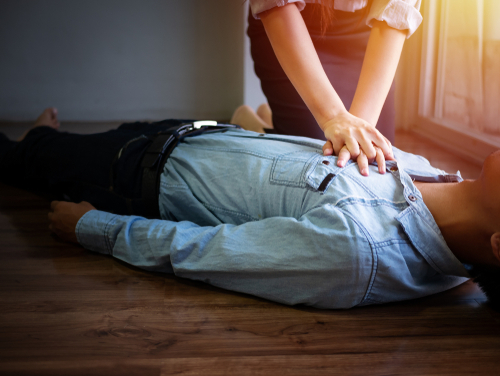 Adult CPR, or Cardio Pulmonary Resuscitation, is vital for restarting someones heart if it stops beating. If someone is unconscious, check to see if they are breathing and if they are not, commence CPR.
Adult CPR, or Cardio Pulmonary Resuscitation, is vital for restarting someones heart if it stops beating. If someone is unconscious, check to see if they are breathing and if they are not, commence CPR.
Arriving at the Scene
As a First Aider, the first thing you should always do is check for dangers. Your safety is critical because, without you, the patient has a 0% chance of survival if there is nobody else around. Also, instead of there being one casualty, there is now the person needing CPR and yourself with injuries.
If there are no dangers, approach the person. As you are doing this, talk to them. Tap their shoulder, shout and gently shake them to try and get a response. All you are trying to do is to rouse the patient. If they respond, they will definitely not need CPR. For example, they may have just been asleep or may be drunk and just having a rest.
If there is no response, you need to think about calling the Emergency Services. However, before this, you need to check their airway. You need to look inside the airway to check for obstructions that might be blocking the airway. This can include liquids, fluids, vomit, blood, false teeth or anything else that might present an airway problem. If there is something in there, it needs to be removed. If you can easily remove it, whilst wearing gloves, take the blockage out. However, do not just blindly sweep your finger down their throat as this may push it further in. Also, if the obstruction is liquid, you can roll them onto their side to allow it to flow out of their mouth.
Checking for Breathing
Once the airway is clear, the next thing to do is to check for breathing. To do this, the airway needs to be opened fully. There are two techniques to do this, the head-tilt chin-lift and the jaw thrust. The jaw thrust is normally only used if the patient has a suspected spinal injury. It is a more advanced technique of opening the airway. You should have the proper training to do this, as it can be quite fiddley to do without training.
To do the head-tilt chin-lift, place one hand on their forehead and the other under their chin. Then tilt their head back and lift their chin, opening their mouth. Place one ear close to their mouth and look down their body. Look, listen and feel for 10 seconds for breath. This may be feeling for breath on the face, seeing the chest rise and fall and hearing the breath. If they are breathing, they should be put in the recovery position and frequently monitored.
Procedure for Adult CPR
If the patient is not breathing, they are in cardiac arrest. Most people expect them to be perfectly still. Yet around 40% of all patients who need CPR may move limbs, twitch or shake. Be aware of these, however, if they are not breathing, continue to commence CPR immediately. The faster you start, the better the outcome is going to be. This means that you have to do all of the above process efficiently. However, there is no point skipping it all and carrying out CPR on a sleeping person, as this could cause serious damage and they will be very angry at you!
The correct position for adult CPR is in the centre of the chest. It is directly above the heart. The palm of one hand goes onto the chest. The fingers of the other hand are linked on top of the first hand. When doing compressions, even though the hand lifts and lowers, the fingers do not come off position. This means you will always carry out compressions in exactly the same place every time.
So once your hands are in the correct position, lock your arms straight. Then compress the chest 5 to 6 cm in-depth. Then you MUST fully recoil by lifting the heel of the hand off of the chest. This is because we are trying to pump blood out of the heart. Every time you do a compression, you have to allow the refill, otherwise, no blood will be transported. The rate of 120 per minute gives the best flow rate of blood up to the brain from each compression. So once you start, continue with the compressions.
Rescue Breaths for Adult CPR
Rescue breaths are optional, however they are advised. Every 30 compressions, you should perform 2 rescue breaths. Alternate between 30 chest compressions and 2 rescue breaths at a rate of 120 compressions per minute. The rescue breaths re-oxygenate the lungs, allowing more oxygen to reach the brain when you recommence chest compressions. To do a rescue breath properly, you must seal their nose by pinching it. Also, make sure that your mouth and theirs makes a full seal, meaning no air will escape and it will all go into the lungs.
Effective CPR
For effective CPR you should try and aim for a maximum of 10 seconds between chest compressions and rescue breaths. For a full list of tips for effective CPR, check out our page on effective CPR.
For more information on training courses, visit our “Courses” page which also includes our First Responder and First Person on Scene (FPOS) Courses. If you have any queries, don’t hesitate to contact us via our website or call us on 01206 805359.

Pingback: The chain of Survival is a simple guide to show you the stages of CPR
Pingback: CellAED® handheld personal AED unit
Pingback: How Home AEDs Could Make a Lifesaving Difference